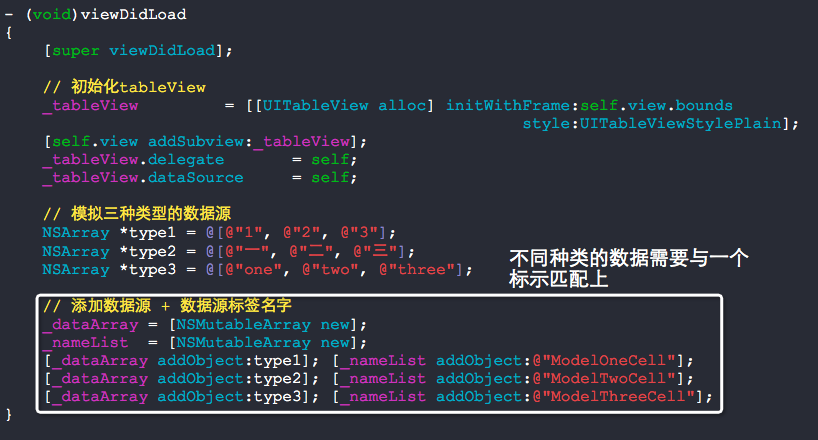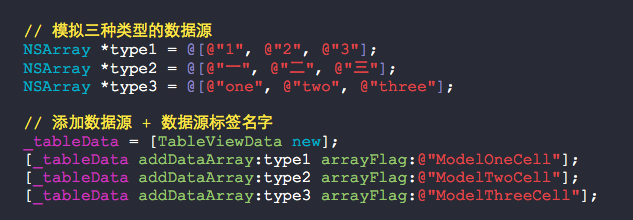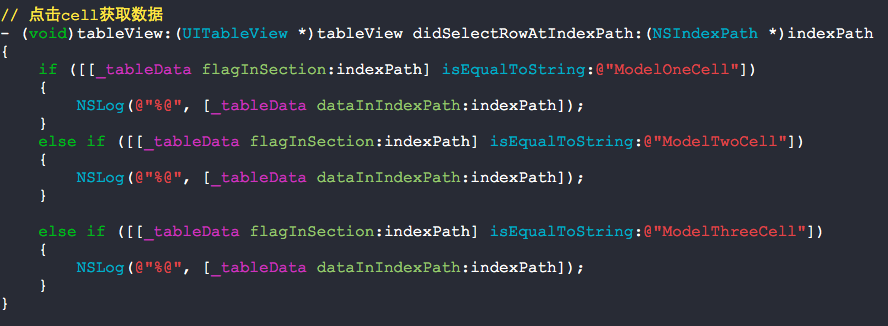快速设置UITableView不同section对应于不同种类的cell
快速设置UITableView不同section对应于不同种类的cell

本文主要是为了写明如何在UITableView中,一个section对应于一种类型的cell,写起来不凌乱.
在不封装任何类的前提下提供如下源码:
请自行创建出3种类型的cell,创建好了就行,你需要创建出ModelOneCell,ModelTwoCell,ModelThreeCell,内容为空
//
// RootViewController.m
// Sections
//
// Copyright (c) 2014年 Y.X. All rights reserved.
// #import "RootViewController.h"
#import "ModelOneCell.h"
#import "ModelTwoCell.h"
#import "ModelThreeCell.h" @interface RootViewController ()<UITableViewDelegate, UITableViewDataSource> @property (nonatomic, strong) UITableView *tableView; // tableView @property (nonatomic, strong) NSMutableArray *dataArray; // 数据数组
@property (nonatomic, strong) NSMutableArray *nameList; // 数组名字 @end @implementation RootViewController #pragma mark - 只初始化一次
#define REUESED_SIZE 100
static NSString *reUsedStr[REUESED_SIZE] = {nil}; // 重用标示
#define REUESED_FLAG reUsedStr[0]
+ (void)initialize
{
if (self == [RootViewController class])
{
for (int i = ; i < REUESED_SIZE; i++)
{
reUsedStr[i] = [NSString stringWithFormat:@"GoodBoy_%d", i];
}
}
} - (void)viewDidLoad
{
[super viewDidLoad]; // 初始化tableView
_tableView = [[UITableView alloc] initWithFrame:self.view.bounds
style:UITableViewStylePlain];
[self.view addSubview:_tableView];
_tableView.delegate = self;
_tableView.dataSource = self; // 模拟三种类型的数据源
NSArray *type1 = @[@"", @"", @""];
NSArray *type2 = @[@"一", @"二", @"三"];
NSArray *type3 = @[@"one", @"two", @"three"]; // 添加数据源 + 数据源标签名字
_dataArray = [NSMutableArray new];
_nameList = [NSMutableArray new];
[_dataArray addObject:type1]; [_nameList addObject:@"ModelOneCell"];
[_dataArray addObject:type2]; [_nameList addObject:@"ModelTwoCell"];
[_dataArray addObject:type3]; [_nameList addObject:@"ModelThreeCell"];
} #pragma mark - UITableView'delegate & dataSource
// 每个区有几个cell
- (NSInteger)tableView:(UITableView *)tableView numberOfRowsInSection:(NSInteger)section
{
return [_dataArray[section] count];
} // 设定tableView有几个区域
- (NSInteger)numberOfSectionsInTableView:(UITableView *)tableView
{
return [_nameList count];
} // cell的初始化以及重用设置
-(UITableViewCell *)tableView:(UITableView *)tableView
cellForRowAtIndexPath:(NSIndexPath *)indexPath
{
// 根据section区域获取几种cell的公共父类
UITableViewCell *cell = [tableView dequeueReusableCellWithIdentifier:reUsedStr[indexPath.section]]; // 根据不同的区域对应创建出该区域的cell
if (cell == nil)
{
if ([_nameList[indexPath.section] isEqualToString:@"ModelOneCell"])
{
cell = [[ModelOneCell alloc] initWithStyle:UITableViewCellStyleDefault
reuseIdentifier:reUsedStr[indexPath.section]];
}
else if ([_nameList[indexPath.section] isEqualToString:@"ModelTwoCell"])
{
cell = [[ModelTwoCell alloc] initWithStyle:UITableViewCellStyleDefault
reuseIdentifier:reUsedStr[indexPath.section]];
} else if ([_nameList[indexPath.section] isEqualToString:@"ModelThreeCell"])
{
cell = [[ModelThreeCell alloc] initWithStyle:UITableViewCellStyleDefault
reuseIdentifier:reUsedStr[indexPath.section]];
}
} // 对cell进行设置
if ([_nameList[indexPath.section] isEqualToString:@"ModelOneCell"])
{
cell = [[ModelOneCell alloc] initWithStyle:UITableViewCellStyleDefault
reuseIdentifier:reUsedStr[indexPath.section]];
cell.textLabel.text = _dataArray[indexPath.section][indexPath.row];
}
else if ([_nameList[indexPath.section] isEqualToString:@"ModelTwoCell"])
{
cell = [[ModelTwoCell alloc] initWithStyle:UITableViewCellStyleDefault
reuseIdentifier:reUsedStr[indexPath.section]];
cell.textLabel.text = _dataArray[indexPath.section][indexPath.row];
} else if ([_nameList[indexPath.section] isEqualToString:@"ModelThreeCell"])
{
cell = [[ModelThreeCell alloc] initWithStyle:UITableViewCellStyleDefault
reuseIdentifier:reUsedStr[indexPath.section]];
cell.textLabel.text = _dataArray[indexPath.section][indexPath.row];
} return cell;
} // 点击cell获取数据
- (void)tableView:(UITableView *)tableView didSelectRowAtIndexPath:(NSIndexPath *)indexPath
{
if ([_nameList[indexPath.section] isEqualToString:@"ModelOneCell"])
{
NSLog(@"%@", _dataArray[indexPath.section][indexPath.row]);
}
else if ([_nameList[indexPath.section] isEqualToString:@"ModelTwoCell"])
{
NSLog(@"%@", _dataArray[indexPath.section][indexPath.row]);
} else if ([_nameList[indexPath.section] isEqualToString:@"ModelThreeCell"])
{
NSLog(@"%@", _dataArray[indexPath.section][indexPath.row]);
}
} // 设定不同种类cell的高度
- (CGFloat)tableView:(UITableView *)tableView heightForRowAtIndexPath:(NSIndexPath *)indexPath
{
if ([_nameList[indexPath.section] isEqualToString:@"ModelOneCell"])
{
return ;
}
else if ([_nameList[indexPath.section] isEqualToString:@"ModelTwoCell"])
{
return ;
} else if ([_nameList[indexPath.section] isEqualToString:@"ModelThreeCell"])
{
return ;
}
else
{
return ;
}
} @end
运行时候的效果如下:

核心思想:

接下来,我们就要来进行封装,达到好用的目的:)
我们把数据源以及数据源标签抽象成一个对象就可以很好的管理这些东西了,以下给出源码:
//
// TableVewData.h
// Sections
//
// Copyright (c) 2014年 Y.X. All rights reserved.
// #import <Foundation/Foundation.h> @interface TableViewData : NSObject // 添加数据源 + 数据源标签
- (void)addDataArray:(NSArray *)array arrayFlag:(NSString *)flag; // 对应区域中的row的个数
- (NSInteger)numberOfRowsInSection:(NSInteger)section; // 有几个section
- (NSInteger)numberOfSections; // 对应于Section上的flag值标签
- (NSString *)flagInSection:(NSIndexPath *)indexPath; // 对应于indexPath中的数据
- (id)dataInIndexPath:(NSIndexPath *)indexPath; @end
//
// TableVewData.m
// Sections
//
// Copyright (c) 2014年 Y.X. All rights reserved.
// #import "TableViewData.h" @interface TableViewData () @property (nonatomic, strong) NSMutableArray *dataArray;
@property (nonatomic, strong) NSMutableArray *nameList; @end @implementation TableViewData - (instancetype)init
{
self = [super init];
if (self)
{
_dataArray = [NSMutableArray new];
_nameList = [NSMutableArray new];
}
return self;
} - (void)addDataArray:(NSArray *)array arrayFlag:(NSString *)flag
{
[_dataArray addObject:array];
[_nameList addObject:flag];
} - (NSInteger)numberOfRowsInSection:(NSInteger)section
{
return [_dataArray[section] count];
} - (NSInteger)numberOfSections
{
return [_dataArray count];
} - (NSString *)flagInSection:(NSIndexPath *)indexPath
{
return _nameList[indexPath.section];
} - (id)dataInIndexPath:(NSIndexPath *)indexPath
{
return _dataArray[indexPath.section][indexPath.row];
} @end
主函数使用情形如下:
//
// RootViewController.m
// Sections
//
// Copyright (c) 2014年 Y.X. All rights reserved.
// #import "RootViewController.h"
#import "ModelOneCell.h"
#import "ModelTwoCell.h"
#import "ModelThreeCell.h" #import "TableViewData.h" @interface RootViewController ()<UITableViewDelegate, UITableViewDataSource> @property (nonatomic, strong) UITableView *tableView; // tableView @property (nonatomic, strong) TableViewData *tableData; @end @implementation RootViewController #pragma mark - 只初始化一次
#define REUESED_SIZE 100
static NSString *reUsedStr[REUESED_SIZE] = {nil}; // 重用标示
#define REUESED_FLAG reUsedStr[0]
+ (void)initialize
{
if (self == [RootViewController class])
{
for (int i = ; i < REUESED_SIZE; i++)
{
reUsedStr[i] = [NSString stringWithFormat:@"GoodBoy_%d", i];
}
}
} - (void)viewDidLoad
{
[super viewDidLoad]; // 初始化tableView
_tableView = [[UITableView alloc] initWithFrame:self.view.bounds
style:UITableViewStylePlain];
[self.view addSubview:_tableView];
_tableView.delegate = self;
_tableView.dataSource = self; // 模拟三种类型的数据源
NSArray *type1 = @[@"", @"", @""];
NSArray *type2 = @[@"一", @"二", @"三"];
NSArray *type3 = @[@"one", @"two", @"three"]; // 添加数据源 + 数据源标签名字
_tableData = [TableViewData new];
[_tableData addDataArray:type1 arrayFlag:@"ModelOneCell"];
[_tableData addDataArray:type2 arrayFlag:@"ModelTwoCell"];
[_tableData addDataArray:type3 arrayFlag:@"ModelThreeCell"];
} #pragma mark - UITableView'delegate & dataSource
// 每个区有几个cell
- (NSInteger)tableView:(UITableView *)tableView numberOfRowsInSection:(NSInteger)section
{
return [_tableData numberOfRowsInSection:section];
} // 设定tableView有几个区域
- (NSInteger)numberOfSectionsInTableView:(UITableView *)tableView
{
return [_tableData numberOfSections];
} // cell的初始化以及重用设置
-(UITableViewCell *)tableView:(UITableView *)tableView
cellForRowAtIndexPath:(NSIndexPath *)indexPath
{
// 根据section区域获取几种cell的公共父类
UITableViewCell *cell = [tableView dequeueReusableCellWithIdentifier:reUsedStr[indexPath.section]]; // 根据不同的区域对应创建出该区域的cell
if (cell == nil)
{
if ([[_tableData flagInSection:indexPath] isEqualToString:@"ModelOneCell"])
{
cell = [[ModelOneCell alloc] initWithStyle:UITableViewCellStyleDefault
reuseIdentifier:reUsedStr[indexPath.section]];
}
else if ([[_tableData flagInSection:indexPath] isEqualToString:@"ModelTwoCell"])
{
cell = [[ModelTwoCell alloc] initWithStyle:UITableViewCellStyleDefault
reuseIdentifier:reUsedStr[indexPath.section]];
} else if ([[_tableData flagInSection:indexPath] isEqualToString:@"ModelThreeCell"])
{
cell = [[ModelThreeCell alloc] initWithStyle:UITableViewCellStyleDefault
reuseIdentifier:reUsedStr[indexPath.section]];
}
} // 对cell进行设置
if ([[_tableData flagInSection:indexPath] isEqualToString:@"ModelOneCell"])
{
cell = [[ModelOneCell alloc] initWithStyle:UITableViewCellStyleDefault
reuseIdentifier:reUsedStr[indexPath.section]];
cell.textLabel.text = [_tableData dataInIndexPath:indexPath];
}
else if ([[_tableData flagInSection:indexPath] isEqualToString:@"ModelTwoCell"])
{
cell = [[ModelTwoCell alloc] initWithStyle:UITableViewCellStyleDefault
reuseIdentifier:reUsedStr[indexPath.section]];
cell.textLabel.text = [_tableData dataInIndexPath:indexPath];
} else if ([[_tableData flagInSection:indexPath] isEqualToString:@"ModelThreeCell"])
{
cell = [[ModelThreeCell alloc] initWithStyle:UITableViewCellStyleDefault
reuseIdentifier:reUsedStr[indexPath.section]];
cell.textLabel.text = [_tableData dataInIndexPath:indexPath];
} return cell;
} // 点击cell获取数据
- (void)tableView:(UITableView *)tableView didSelectRowAtIndexPath:(NSIndexPath *)indexPath
{
if ([[_tableData flagInSection:indexPath] isEqualToString:@"ModelOneCell"])
{
NSLog(@"%@", [_tableData dataInIndexPath:indexPath]);
}
else if ([[_tableData flagInSection:indexPath] isEqualToString:@"ModelTwoCell"])
{
NSLog(@"%@", [_tableData dataInIndexPath:indexPath]);
} else if ([[_tableData flagInSection:indexPath] isEqualToString:@"ModelThreeCell"])
{
NSLog(@"%@", [_tableData dataInIndexPath:indexPath]);
}
} // 设定不同种类cell的高度
- (CGFloat)tableView:(UITableView *)tableView heightForRowAtIndexPath:(NSIndexPath *)indexPath
{
if ([[_tableData flagInSection:indexPath] isEqualToString:@"ModelOneCell"])
{
return ;
}
else if ([[_tableData flagInSection:indexPath] isEqualToString:@"ModelTwoCell"])
{
return ;
} else if ([[_tableData flagInSection:indexPath] isEqualToString:@"ModelThreeCell"])
{
return ;
}
else
{
return ;
}
} @end
添加数据源:

见名知意:

使用很便利:


快速设置UITableView不同section对应于不同种类的cell的更多相关文章
- collectionView代理方法快速设置cell大小上下左右间隔
#define JianGe 25 #define GeShu 4 #define ScreenWidth ([UIScreen mainScreen].bounds.size.width) #def ...
- [Xcode 实际操作]五、使用表格-(5)设置UITableView的单元格背景颜色
目录:[Swift]Xcode实际操作 本文将演示单元格背景颜色的设置 在项目导航区,打开视图控制器的代码文件[ViewController.swift] import UIKit //首先添加两个协 ...
- [Xcode 实际操作]五、使用表格-(4)设置UITableView单元格数据库源
目录:[Swift]Xcode实际操作 本文将演示如何自定义表格的数据来源. 在项目导航区,打开视图控制器的代码文件[ViewController.swift] import UIKit //首先添加 ...
- [Xcode 实际操作]五、使用表格-(3)设置UITableView单元格图标
目录:[Swift]Xcode实际操作 本文将演示如何给表格行设置图标. 打开资源文件夹[Assets.xcassets], 在资源文件夹中导入两张图片:一张彩色,一张灰色,作为单元格的图标. [+] ...
- [Xcode 实际操作]五、使用表格-(2)设置UITableView单元格高度
目录:[Swift]Xcode实际操作 本文将演示如何制作一个自定义行高的表格视图 在项目导航区,打开视图控制器的代码文件[ViewController.swift] import UIKit //首 ...
- 设置UITableView的separatorInset值为UIEdgeInsetsZero,分隔线不最左端显示的问题
一.问题描述 UITableView分割线要显示到最左端 查看UITableView的属性,发现设置separatorInset的值可以自定义分割线的位置. @property (nonatomic) ...
- 分享一个快速设置背景的js 自动获取背景图的长宽
我来分享一个快速设置背景的js (需要jq支持!) 快速切图铺页面用---就是不需要手动输入背景图的长宽 自动获取背景图的长宽 : <div class="wrap"> ...
- 设置UITableView背景透明/监听cell左边的删除按钮的点击事件
_tableView = [[UITableView alloc] init]; _tableView.delegate = self; _tableView.dataSource = self; _ ...
- 【大盛】HTC one/M7 ROM 最新本地化OrDroid8.2.6 高级、快速设置 永久root 更多自定义 稳定 流畅
了解更多:点击下载ROM和学习更多 ROM版本 HTC-one_OrDroid8.2.6 ROM作者 雪狼团队·大盛 http://weibo.com/DaShengdd Android版本 Andr ...
随机推荐
- JavaScript数据结构-17.图结构
<!DOCTYPE html> <html> <head> <meta charset="UTF-8"> <title> ...
- nginx 配置静态资源路径(url不同于static path)
目的 用nginx做静态资源代理可以减少请求对后台服务器的压力,使响应更加迅速. 配置 情景一 url : 127.0.0.1:8000/images ...
- Oracle 创建表空间和用户
创建用户: 建立表空间和用户的步骤: 用户 建立:create user 用户名 identified by "密码"; 授权:grant create session to 用户 ...
- Golang真言
Don't communicate by sharing memory, share memory by communicating. Concurrency is not parallelism. ...
- Java 实现两个整数变量的交换
class OperatorTest { public static void main(String[] args) { int a = 10; int b = 20; System.out.pri ...
- ListView和Adapter
<RelativeLayout xmlns:android="http://schemas.android.com/apk/res/android" xmlns:tools= ...
- WCF-绑定模型(一)
一.利用BasicHttpBinding实现消息通信 WCF基础架构由服务模型层和信道层构成,而绑定是两层直接的纽带.绑定创建了处理消息的信道栈,实现消息的传输和处理.在绑定模型中涉及很多通信对象,信 ...
- Golang报错mixture of field:value and value initializers
Golang 在使用匿名成员初始化时,如果出现 mixture of field:value and value initializers 是因为初始化的方式不对,见代码: package main ...
- ASP.NET之Jquery入门级别
1.Jquery的简单介绍 1)Jquery由美国人John Resig创建.是继prototype之后又一个优秀的JavaScript框架. 2)JQuery能做什么?JQuery能做的普通的Dom ...
- 使用NOPI读取Word、Excel文档内容
使用NOPI读取Excel的例子很多,读取Word的例子不多. Excel的解析方式有多中,可以使用ODBC查询,把Excel作为一个数据集对待.也可以使用文档结构模型的方式进行解析,即解析Workb ...
